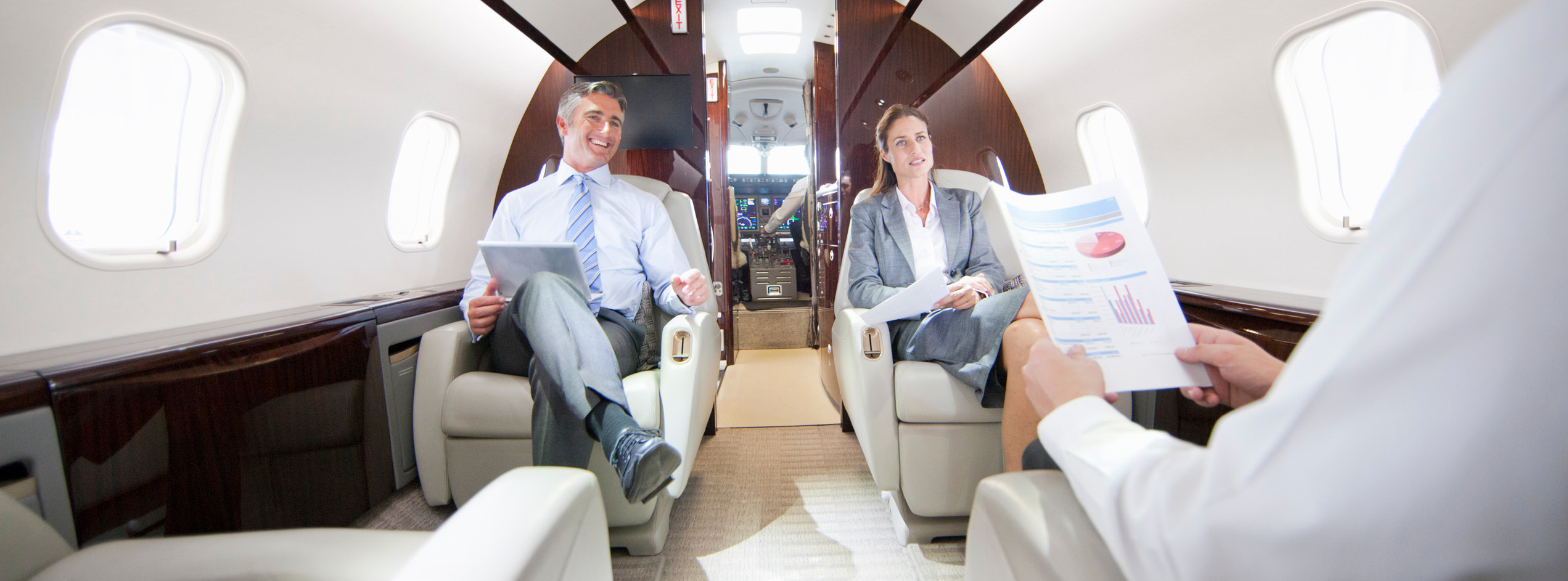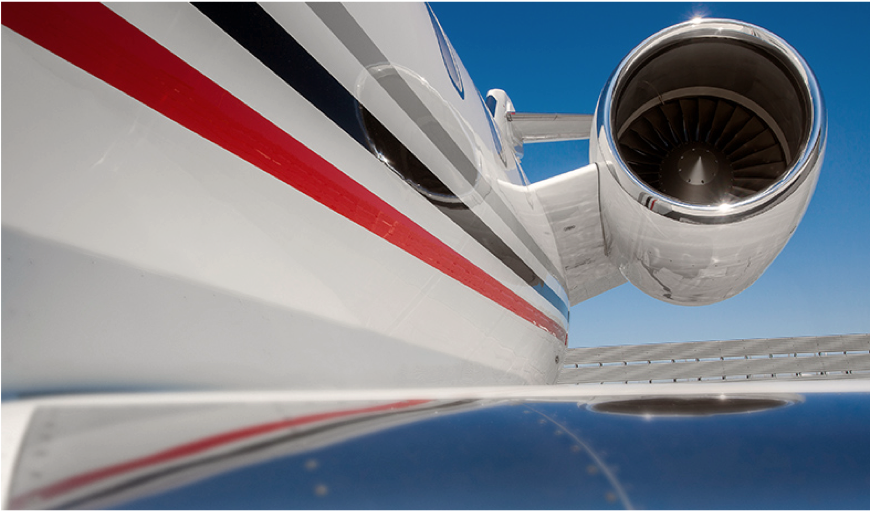
A Beginner’s Guide to Charter
At IEAG, we’ve been serving a vast roster of aviation industry clients for more than 60 years – and we are excited to share various key lessons with you that we learned along the way. Our Insights series offer best practices and gained know-how, practical guidance and advice, and help educate and inform in various areas of interest to our aviation community. Please don’t hesitate to reach out with comments and feedback at insights@innotech-execaire.com so that we can serve you better.
Do you require flexible business travel but are not quite ready to embrace the idea of owning and operating your own business jet?

One potential solution you can consider is using charter services, which involves many different scenarios to fit your travel needs. It’s not always easy to know where to start, so Insights had an in-depth chat with IEAG’s Sales Director, Executive Aircraft Charters, Kevin Robinson, to explore the ins and outs of business aircraft charter and the various operator offerings available to you if you are interested in this form of travel. Kevin has two decades of sales experience with Innotech-Execaire and Bombardier Aerospace. From the uninitiated to the most seasoned charter client, his expertise will help guide clients to find exactly what they want and need.
Becoming an educated charter consumer when you’re new to the game: what to consider?
The first thing you’ll want to understand when you’re thinking about using a charter service is why it’s advantageous. Right now, during a global pandemic, one of the foremost reasons is safety. As a charter flyer, your airport touchpoints are few since in the majority of cases, you go directly to your aircraft’s fixed base of operation (FBO), park your car and board the aircraft, with your bags in hand. “In comparison to a major airport, there are no long lines of hundreds of passengers waiting to clear security or customs and, in a chartered aircraft, you’ll typically be travelling with a minimum number of passengers – usually not more than 12 depending on the size of your travelling party and the class of aircraft,” adds Kevin. Our IEAG Insights #1 provides more detail on the safety advantages associated with business aircraft travel.
Safety is one aspect, and an important one, but there are also clear benefits that extend well beyond that. “It’s about saving time,” explains Kevin. In most cases, passengers can arrive at their FBO as little as 15 minutes before the scheduled flight departure time without having to worry about missing their flight – the charter operator is usually well versed in dealing with last-minute changes and accommodating any scheduling issues as they arise with a flexibility you won’t see with the commercial airlines. And between getting in and out of the airport and arrival times, you can save one to two hours. “A business traveller with a hectic schedule can accomplish a lot more in a day,” says Kevin. Moreover, business jets have access to smaller airports that are not available via commercial travel. “Sometimes this can get you even closer to your ultimate destination,” he points out.
When you are considering chartered jet travel, there are some basic elements you’ll need to look at as part of any decision-making process.
Examples include:
- Where do you need to go specifically?
- What’s your departure point?
- Do you need to make any stops on the way? Or do you need to fly non-stop?
- Can your travel arrangements be flexible?
- How many passengers on the trip?
- Do you have cabin requirements or preferences? (Phone/internet; sleeping capability, lavatory) • What about other special needs? (A flight attendant, meal service, accommodation for passengers with disabilities or allergies)
“Once you’ve identified your broader needs, you can get specific about the rest,” says Kevin.
Choosing an operator or a broker: a checklist
Finding a charter operator is easy, finding the right one is difficult: there are plenty of ways to locate a roster of operators, whether you use aviation industry publications and directories, the internet or word of mouth. The challenge is finding an operator that meets the highest standards of excellence in every area. According to Kevin, “There are certain things, such as safety, that really matter, both from an aircraft and aircraft operation perspective.” Let’s go through all the details that matter most.
SAFETY
Make sure the operator has a proven safety record. “One way to validate operator safety is through the safety ratings and certifications done by independent and industry recognized third-party auditors,” Kevin emphasizes. There are bodies that undertake safety certifications, such as ARG/US (Aviation Research Group/US) or WYVERN and ISBAO (International Standard for Business Aircraft Operations), among others. “Research your operator and verify their audit history and safety ratings. You can easily search these certifications on their websites,” says Kevin. “In addition, most reputable operators proudly display their certifications on their websites.” When doing your own research, the highest possible ARG/US operator rating is Platinum and the highest IS-BAO compliance accreditation is Stage 3. All certifying bodies have their own rating systems; they might use platinum, gold, silver, etc., so be sure to educate yourself to know what they are and that your operator is rated accordingly.
MAINTENANCE
Kevin points out that whether an aircraft operator does their own maintenance or outsources it should be considered in your selection. And if it’s outsourced, is it always outsourced to the same supplier? “It’s like getting your car serviced,” Kevin says. “Knowing there’s quality and consistency in the maintenance service is paramount. And if the operator in question takes care of their own maintenance, all the better,” he adds. “Dispatch reliability can be directly correlated to maintenance availability. If Maintenance staff is on site, it usually suggests a solutions-oriented operator that has a plan when a part needs to be changed or other maintenance issues come up.”
If an aircraft doesn’t have a home base, that’s often an indication that it’s maintained by different maintenance companies – and possibly unknown third parties. “As the individual chartering the aircraft, you’ll want to know these details – and be able to ask about records,” Kevin advises.
OPERATING CERTIFICATES AND HISTORY
In Canada, every operator has an Aircraft Operating Certificate issued by Transport Canada. Elsewhere, it would be the relevant national authority. Says Kevin, “It’s important that you are aware of just how long the operator you are considering has been in business –longevity of operations is typically a good indicator of reliability and a proven safety culture.
Kevin underscores that stringent rules apply to charter operators. It is important that whatever operator you select be an authorized and licensed commercial carrier for the purposes of your charter trip. Beware of illegal charters as these are subject to stiff fines and penalties for operators looking to “bend the rules.” A charter is illegal when an aircraft that is certified and authorized solely for private use and operations is instead used to commercially transport fare-paying passengers. The reason that this distinction is important is that regulators place additional operating rules on commercial carriers versus private operations. “It hurts our industry when operators don’t follow the rules, not to mention that passengers should be informed and never be put at risk.”
CREW
Know the qualifications of your pilots. “This is so important,” says Kevin. “You’ll want to know their overall experience in flying the type of aircraft you are considering for charter. Are they senior or junior? Do they come from a military background or from commercial airlines? Don’t hesitate to ask the questions,” he highlights.
In addition, crew duty hours must be respected. Have they had adequate rest time between flights? “Any breach means passengers are put in jeopardy – and charter operators face heavy fines. You’ll want to make sure your operator doesn’t compromise on safety when scheduling crew duty,” says Kevin.
At the end of the day, it comes down to reputation, Kevin insists. “You need to be aware of the operator’s reputation. You need to know who you’re working with and relying on for your travel experience.”
USING A BROKER
According to Kevin, working with brokers can be advantageous in many situations. For example, if you are a nomadic flyer, doing business at multiple locations without a set routine and your home base is not important, a broker can be valuable. A good broker will find you the best solution for your circumstances,” he explains. “Charter brokers can help ensure you get the right deal, but remember you are also paying the broker for his services,” Kevin points out. If you are always going to similar locations, flying out of the same home base and coming back to home base, a direct relationship with a charter operator from that base may be the better solution. “Brokers are great for introducing you to operators they trust and have used in the past. Ultimately, it’s up to the broker to prove his worth to the client,” he explains.
Aircraft selection and pricing: factors that affect your choice
As Kevin points out, many business travellers are used to flying commercial, so they’ll initially be comparing a first-class ticket to flying private. This is not really comparing apples to apples, and a whole different set of criteria needs to be applied to determining your preferences when chartering a business jet. Price is definitely a factor but this can depend on other criteria such as where you are flying, the duration of the trip, whether it’s a one-way or round-trip, and the number of passengers. These criteria can affect the choices you make in various ways.
BUDGET AND DURATION
If you’re on a budget and it’s a short-haul domestic flight, you might select an entry-level turboprop aircraft rather than a jet, because the length of time you’re flying may not justify the need for a larger, faster and more expensive jet aircraft. “True, there might not be as much legroom in the smaller aircraft,” he points out, “but on a short flight, the comfort compromise is more manageable.” If you’re still on a budget for that short-haul destination but you need speed, then you might want to consider upgrading to a light jet. This category of aircraft is still less expensive than larger cabin jets, with a distinct speed advantage over turbo-prop aircraft.
For longer-haul cross country or international destinations, you’ll likely be more concerned with a few other trip variables as well. “With longer distances, trips get more complicated – so depending on the aircraft, you may need to think about a rest stop on the way – and in some ultralong-haul cases, a crew swap as well,” Kevin adds.
To this end, another factor that comes into play is the duration of the trip. “Depending on how long you’re staying, the operator may elect to leave the plane staying at the location or returning to base,” says Kevin. “In other words, does your budget allow you to keep the aircraft there by paying retention fees, or will you find another return-home option?
To decide whether the retention fee is worth it, you’ll want to consider whether your days away are greater than the hours flown.” Kevin also points out that it may or may not make sense to use the same operator you flew there with, especially for trips with a longer duration. “If they don’t have a base at your destination, they’ll have to fly out there to pick you up – so it may be more budget- conscious to fly home with an operator who is based at your destination point.”
PASSENGER LOAD
Passenger load is also key as more passengers usually means a larger jet and a higher price point. If there are more than eight passengers, you’ll need to consider chartering a different category of aircraft, which translates into a different budget. Turboprops and light jets can typically accommodate up to eight passengers with shorter distances of 600-2000nm, midsize/ super mid jets can expand to between 8-10 passengers with available coast-to-coast range typically 2000-4000nm, depending on the model of aircraft. The next category up being a heavy jet can accommodate between nine to 12 passengers and capable of cross continent flights in the range of 4000-5000 nm. Finally, the ultra-long class certain high-density configurations can hold 12- 19 passengers with ranges nonstop of up to 5000-7000 nm. Be sure to understand cyclicality and peak periods. Pricing is also affected by the time of year you’re travelling. Is it a peak period? And Kevin makes clear that the same peak periods tend to apply to the entire North American market, so that should be a consideration.
Pricing structures and payment options
Chartering a business jet can involve different pricing structures or payment options, some of which may accommodate your budget better or have the inherent flexibility you are looking for. Kevin helps us explore the main options.
On-Demand Charter: This involves receiving various quotes and options for an aircraft requirement with no other commitment other than the specific trip.
Block hours: This involves purchasing 25, 50, 75, or 100 hour time blocks which can be used over a pre-determined period of time and typically relates to a specific aircraft operator.
Jet Card Broker Agreements: These are similar to a block charter arrangement in the sense that you purchase 25 to 50 hours in a specific category or type of aircraft. “They will be operated under charter regulations by one – or possibly more than one – charter operator, all of which have been approved by the card provider,” explains Kevin. “If this is the way you choose to go, make sure you know who the operator will be for each trip, or those generally used by the jet card provider. Then you’ll need to do your due diligence on their reputation and safety record.”
One-Way / Empty Legs: This can be offered through a broker or operator and involves an opportunity to significantly reduce costs by as much as 50%. These options typically become available closer to departure dates and are often snapped up quickly, depending on the routing. Kevin stresses that in such situations, flexibility could save you a lot.
Insurance and legal considerations
You will want to make sure that your operator’s insurance coverage is adequate. Some clients ask to be covered by the operator’s insurance provider but you will also want to check with your own (or your company’s) insurance provider to determine whether chartered aircraft are covered. “All passengers can be insured by the operator based on elevated insurance requirements,” Kevin explains. “Proof of insurance should be provided prior to the flight that identifies the type of aircraft being used as well as the registration number or serial number.”
In terms of legal considerations, Kevin says that arranging a one-time ad-hoc charter will not require legal counsel but other arrangements might. “Anything involving a contract, like jet cards for example, means you should read the fine print,” he adds.

Indeed, there is much to think about when considering whether chartering an aircraft could be a realistic option for managing your travel plans. But with these guidelines from a charter expert, you’ve got a checklist in hand to help you make your decision.

